Imagine yourself meandering along the banks of two of the world’s most famous rivers — the mighty Mississippi, the lifeline of America’s heartland, and the grand Amazon, the pulsing artery of the South American rainforest. These rivers, while thousands of miles apart, share a common, thrilling thread of life — venomous snakes.
Think about the quick flash of scales in the undergrowth, the distinctive rustle of dry leaves, and that quiet, heart-stopping moment when you come across these fascinating creatures. From the hypnotically patterned northern copperhead of the Mississippi to the stealthy, lethal bushmaster of the Amazon, these river basins are a hotbed of slithering intrigue.
In this article, we’ll plunge into these captivating ecosystems, compare the diversity of venomous snakes found in each, and analyze their unique behaviors and adaptations. We’ll also break down the potency of their venoms and their encounters with humans.
So, grab your virtual explorer’s hat, lace up your boots, and join us on this riveting journey.
Understanding the Mississippi River Ecosystem
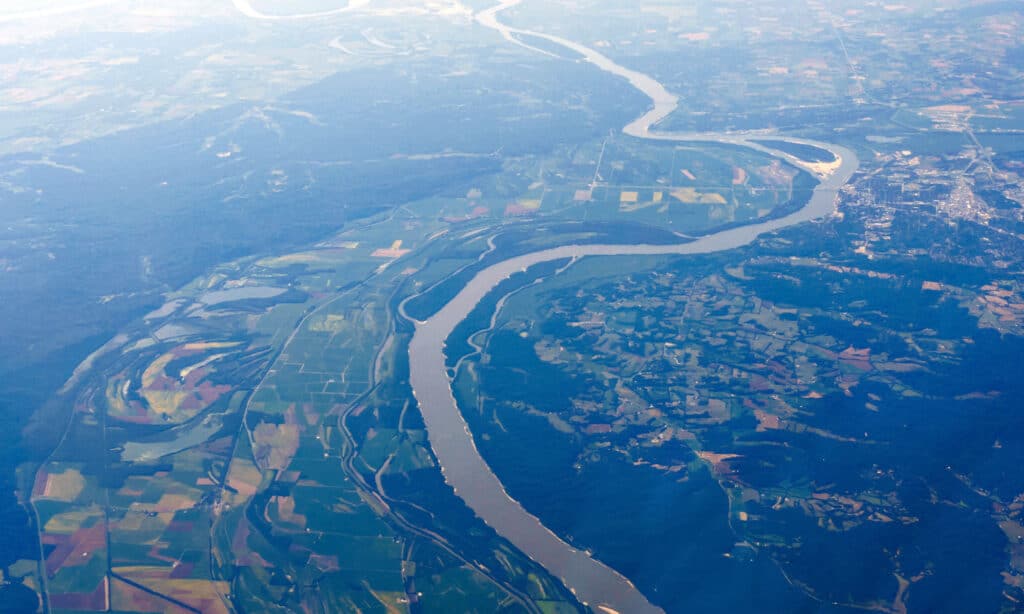
At its deepest point, the Mississippi River can reach 200 feet!
©RaksyBH/Shutterstock.com
Let’s set sail on our first destination — the Mississippi River. Stretching over 2,300 miles, this mammoth river doesn’t just dominate the American landscape; it’s also a bustling hub of life, home to a dizzying array of creatures, including our scaly friends.
The River’s Domain: From North to South
The Mississippi River runs from Minnesota‘s Lake Itasca, meandering southwards until it spills into the Gulf of Mexico. This journey traverses diverse landscapes, from the frozen north, through verdant plains, down to the steamy south.
Ecosystem Diversity: A Melting Pot of Habitats
Mississippi‘s mighty river doesn’t roll alone; an intricate network of tributaries, backwaters, and wetlands supports it. Together, these habitats create a patchwork of ecosystems, each offering a unique home for various species.
The Residents: A Symphony of Life

Blue catfish is one of the many fish species that inhabit the Mississippi River.
©Billy Ogle/Flickr – License
From soaring eagles to submerged catfish, the Mississippi River is a haven for an estimated 260 species of fish, over 300 bird species, and a plethora of mammals and reptiles — including our venomous pals.
Climate Influences: A Seasonal Dance
The climate along the Mississippi varies from the chilly north to the balmy south, and with it, the active seasons of its wildlife. For our slithery subjects, this means a seasonal dance of activity and hibernation.
Understanding the Amazon River Ecosystem
Now, let’s hop on an imaginary flight southward, way down to the Amazon River. This legendary waterway is more than just a river — it’s the heart of the world’s largest rainforest. So, let’s dive in and take a closer look at this lush, vibrant ecosystem.
Journey of the Amazon: From Mountain to Ocean
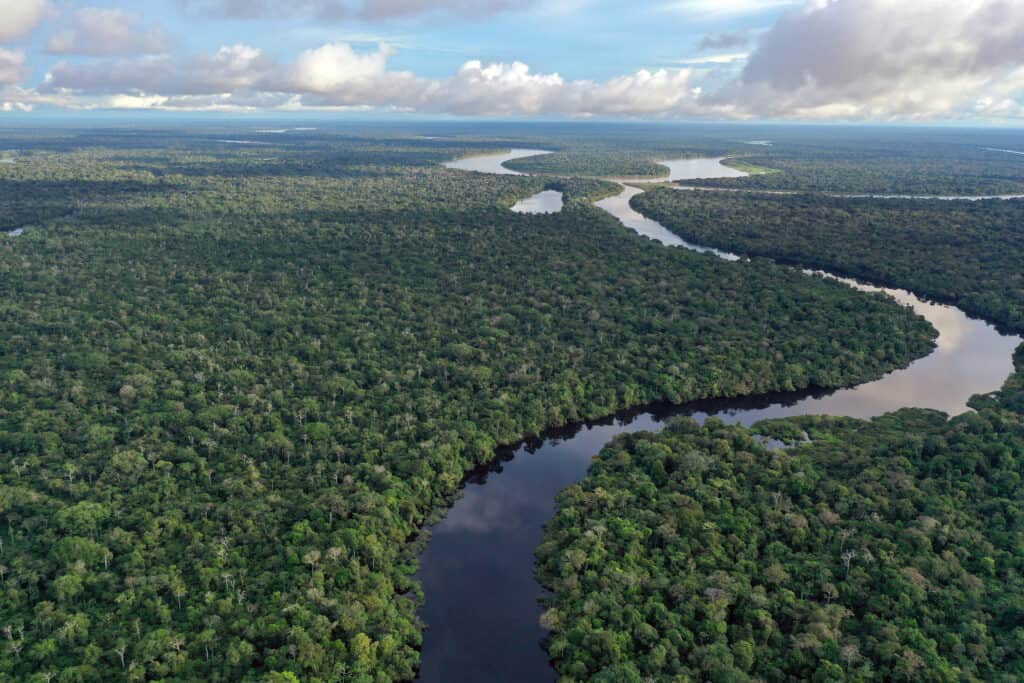
The Amazon River is the world’s biggest river.
©iStock.com/Rhett Ayers Butler – Mongabay
The Amazon River springs to life in the Peruvian Andes and stretches a mind-boggling 4,000 miles to its mouth in the Atlantic Ocean. This epic journey takes it through an amazing array of landscapes, from high-altitude cloud forests to dense, lowland rainforests.
Land of Biodiversity: A Tapestry of Life
The Amazon River Basin houses the most biodiverse rainforest on Earth. We’re talking a staggering variety of habitats here — from deep river channels and flooded forests to vast savannahs and swampy marshes, each one teeming with life.
Amazon Inhabitants: The Symphony of the Rainforest

The red-bellied piranha, also known as the red piranha (
Pygocentrus nattereri), is commonly found in the Amazon River.
©Tatiana Belova/Shutterstock.com
The Amazon is home to a myriad of species and is the last refuge on Earth for many of them. There are jaguars prowling the forest floor, pink river dolphins, macaws squawking in the canopy, poison dart frogs, piranhas patrolling the rivers, and, of course, countless snakes slithering in between.
Climate Patterns: A Steady Tropical Beat
Unlike the Mississippi, the Amazon enjoys a relatively stable tropical climate. Unfortunately, this year-round warmth and high humidity make it a 24/7, 365-day party for most of its residents, including our venomous cohabitants.
Venomous Snakes in the Mississippi River Region
The mighty Mississippi River, flowing right through America’s heartland, is home to an astonishing variety of life. Among them, some creatures command respect and caution — the venomous snakes. Let’s delve deep into the world of these remarkable reptiles.
Northern Copperhead

Northern copperhead snakes are one of North America’s most common species of venomous snakes.
©JacobLoyacano/Shutterstock.com
We begin our journey with the Northern Copperhead. This creature prefers to set up residence in the rocky, hilly, and wooded areas adjacent to the river. It is distinguishable by its thick body, copper-red head, and the unique hourglass pattern that adorns its back.
Although the Northern Copperhead boasts a beautiful exterior, it carries a dangerous secret — a potent venom. It primarily uses this venom for hunting, but when threatened, it won’t hesitate to defend itself. A bite from this snake can cause extreme pain, tissue damage, and even systemic effects in severe cases.
Cottonmouth (Water Moccasin)

Water moccasins are very common in wetlands.
©Seth LaGrange/Shutterstock.com
Next on our list is the cottonmouth, also known as the water moccasin. It thrives in the wet environments lining the Mississippi River. Marshes, swamps, and the river’s edge are its playground. However, the Cottonmouth is infamous for its ill temper and can be recognized by its stout body, dark color, and the white inner lining of its mouth.
The Cottonmouth has a venom that’s not to be underestimated. Like the copperhead, its venom is hemotoxic, damaging tissue and affecting the circulatory system. If it feels cornered or threatened, it will strike, so keeping a respectful distance is essential.
Eastern Diamondback Rattlesnake
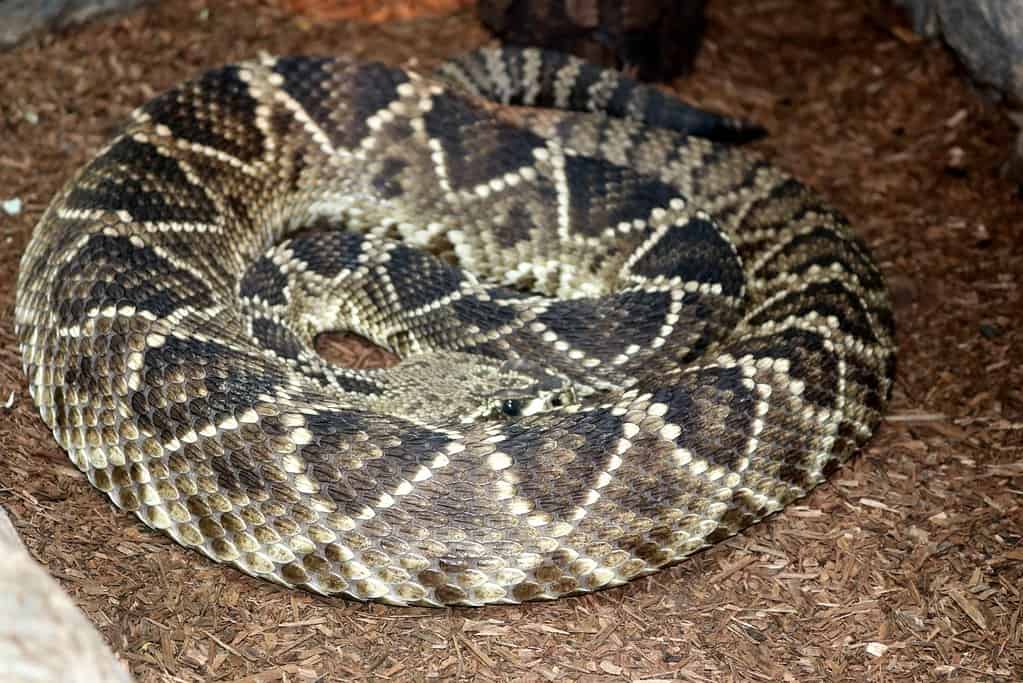
The Eastern diamondback
rattlesnake
gets its name from the beautiful markings along its body.
©Sanjiv Shukla/Shutterstock.com
Preferring drier locales, the eastern diamondback rattlesnake stands out as the largest venomous snake in North America. It suns itself in pine forests and sandy areas near the river. This snake, with its diamond pattern along the back and its signature rattle, is an icon of American wildlife.
The venom of the eastern diamondback is notably potent. A bite from this snake can cause severe systemic effects and is considered a medical emergency. Yet, despite its fearsome reputation, the eastern diamondback prefers flight over fight and will only attack if it feels no other option is left.
Venomous Snakes in the Amazon River Region
Let’s travel south to another river of legendary proportions — the Amazon. This sprawling river basin, teeming with life, is a veritable treasure trove of biodiversity. But today, we’re not here for the cute and cuddly. We’re here for the fanged and venomous — the serpents of the Amazon.
Fer-de-Lance (Bothrops Atrox)
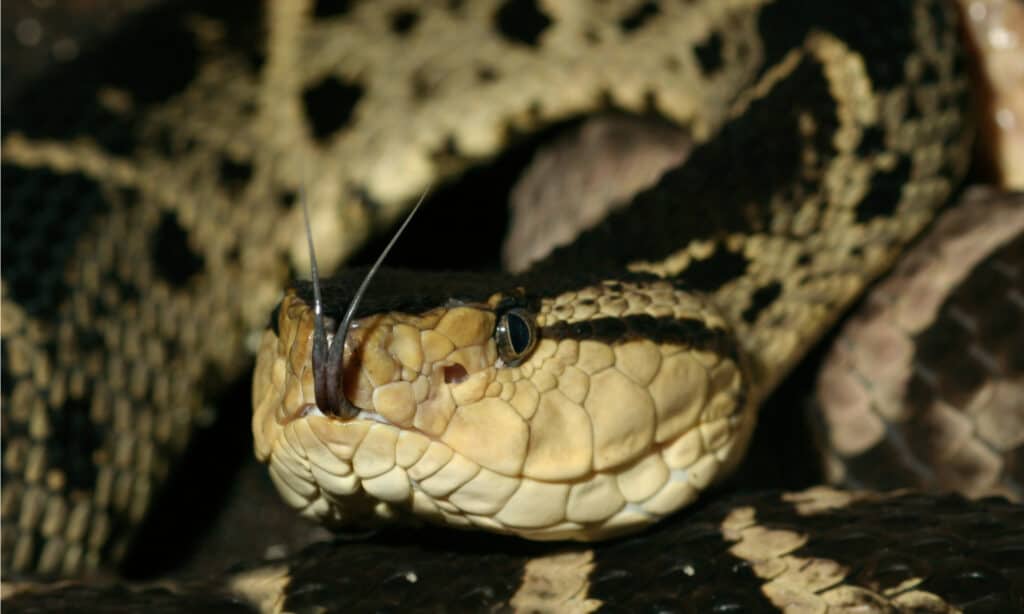
This potent snake can inject around 260 mg of venom per bite, and the record says that some can even inject 800 mg.
©Mark_Kostich/Shutterstock.com
Meet the Bothrops atrox or the fer-de-lance, one of the most feared residents of the Amazon. This snake likes to keep low, often found slithering in lowland areas and rainforests. It sports a slender body adorned with a series of dark diamond-shaped patterns — a beautiful but lethal one.
The Fer-de-lance holds the dubious honor of being responsible for most snakebite incidents in its region. Its venom, a potent cocktail of toxins, causes tissue damage and can lead to severe systemic symptoms. While most bites are not fatal with proper medical treatment, they’re definitely not pleasant.
Bushmaster (Lachesis muta)
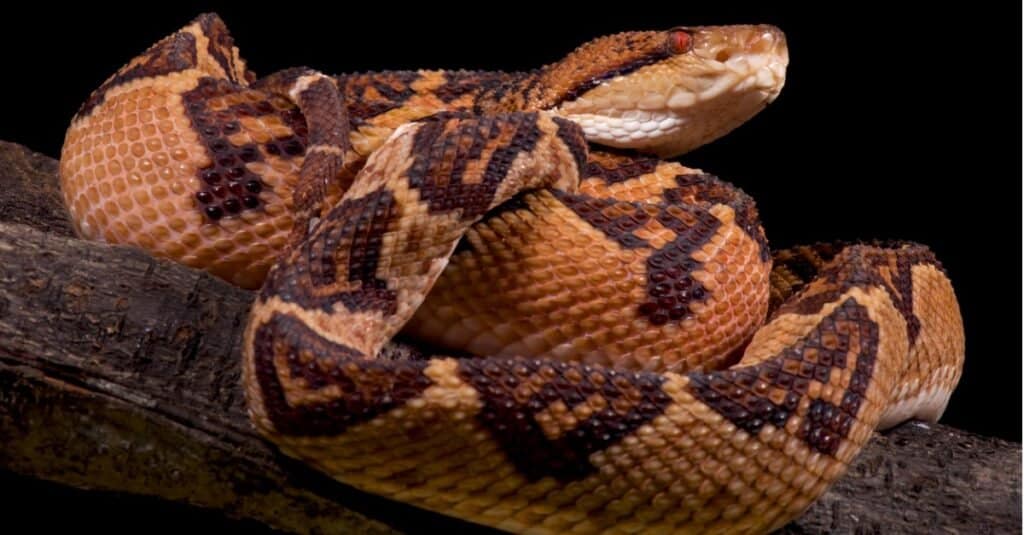
Each species of bushmaster snake have a black line that runs behind its eyes.
©iStock.com/reptiles4all
Next up is the bushmaster, or Lachesis muta, the longest venomous snake in the Americas. It prefers the cover of the Amazon’s thick forest floor. With its reddish-brown body and black or dark brown blotches, it’s well-camouflaged in the leaf litter.
The bushmaster’s venom is one of the most deadly in the Amazon. A bite from this snake can lead to a rapid drop in blood pressure and heart failure. However, encounters with humans are rare, given the snake’s reclusive nature and preference for remote areas.
Yarará Lancehead (Bothrops Jararaca)

The
Bothrops jararacais a terrestrial snake that spends most of its time on the ground.
©iStock.com/reptiles4all
Lastly, we meet the common lancehead or Bothrops jararaca. This snake inhabits a variety of environments in the Amazon, from forests to open savannahs. Its slender body and patterned skin offer excellent camouflage among the vegetation.
The venom of the Yarará Lancehead is highly toxic. A bite can result in a range of symptoms, from local pain and swelling to serious systemic issues, including bleeding disorders and kidney failure. Despite the danger it poses, this snake prefers to avoid human interaction when possible.
Comparative Analysis: Mississippi River vs. Amazon River
Now that we’ve had an in-depth look at the venomous snakes of both the Mississippi and Amazon River regions, it’s time to square them off, crunch some numbers, and delve deeper into their fascinating traits and characteristics.
The Numbers Game
Starting with the raw figures, the Amazon River, with its tropical climate and diverse habitats, boasts about 17 species of venomous snakes. On the other hand, the Mississippi River region, stretching over various climates and habitats, is home to approximately 6 species of venomous snakes.
Remember, a greater variety doesn’t necessarily translate into more encounters or higher danger. Instead, factors such as population density, human activity, and the vastness of the region all play into how often we might run into these slithering residents.
Venom Potency: A Closer Look

Some snake venom is cytotoxic, which means it destroys cells. It can cause severe pain, swelling, bleeding, tissue damage, and even death if left untreated.
©joloei/Shutterstock.com
When it comes to venom, it’s not just about the burn; it’s about the brew. Mississippi River region venomous snakes, like the eastern diamondback rattlesnake, carry hemotoxic venom. This venom, when injected, can cause necrosis, disrupt blood clotting, and lead to systemic effects. It’s a fearsome concoction, with the Eastern Diamondback’s venom yield being about 400-450 mg on average.
In contrast, venom from the Amazon River’s dangerous snakes, like the Bushmaster, contains both hemotoxins and neurotoxins. This toxic mix can lead to tissue damage, nerve function disruption, and cardiovascular issues. A mature Bushmaster can deliver an average venom yield of around 500-550 mg, often with more severe effects than its Mississippi counterparts due to the neurotoxic component.
Behavioral Traits: Aggression vs. Avoidance
Moving onto behaviors, snakes along both rivers, including the cottonmouth and bushmaster, are not aggressive. Instead, they try to avoid interactions with people whenever possible. The difference is that the cottonmouth is more likely to stand its ground in an attempt to scare you away.
Survival Strategies: Generalists vs. Specialists
Finally, let’s talk about adaptability. Mississippi’s venomous snakes are generally versatile, adapting to a wide range of environments, from wetlands to forests and rocky areas.
In contrast, Amazonian snakes display remarkable specialization. For instance, the Common Lancehead can thrive in diverse habitats, from dense forests to open savannahs, while the Bushmaster is a master of disguise in the forest floor’s leaf litter.
Embracing the Diversity
When comparing the venomous snakes of the Mississippi and Amazon River regions, it’s not a contest of ‘better’ or ‘worse.’ Instead, it’s a celebration of biodiversity, adaptation, and survival strategies that these remarkable creatures have developed over millennia. As we respect their habitats and understand their behaviors, we can coexist safely and continue to marvel at their extraordinary existence.
Key Takeaways
We’ve journeyed through the slithery undergrowth of the Mississippi and navigated the leaf-littered floor of the Amazon. We’ve come face to face with the scale-clad residents of these river basins, from the thick-bodied copperhead to the elusive bushmaster.
In this wild exploration, we’ve learned that both regions host an amazing variety of venomous snakes. We’ve compared their venom potency, dug into their behaviors, and appreciated their unique adaptations. But remember, it’s not a competition — each river region is fascinating in its own right.
We’ve come to understand that these snakes aren’t just chilling villains waiting in the wings. Instead, they’re integral parts of their ecosystems, each one playing its role in maintaining the balance of nature. So the next time you’re out exploring, remember to give them a tip of your hat (from a distance, of course).
The photo featured at the top of this post is © Jeff W. Jarrett/Shutterstock.com
Discover the "Monster" Snake 5X Bigger than an Anaconda
Every day A-Z Animals sends out some of the most incredible facts in the world from our free newsletter. Want to discover the 10 most beautiful snakes in the world, a "snake island" where you're never more than 3 feet from danger, or a "monster" snake 5X larger than an anaconda? Then sign up right now and you'll start receiving our daily newsletter absolutely free.
Thank you for reading! Have some feedback for us? Contact the AZ Animals editorial team.






